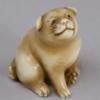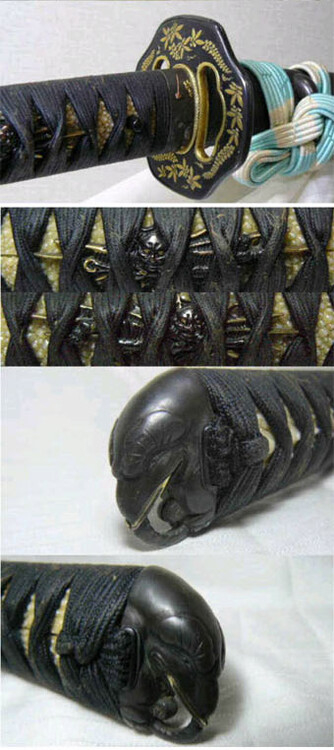-
Posts
341 -
Joined
-
Last visited
-
Days Won
2
Content Type
Profiles
Forums
Events
Store
Downloads
Gallery
Everything posted by leo
-
Even though this might be a very rare piece, I dislike the design. Reminds me of old Soviet monuments where members of the workers class hold hammers or sickles Martin
-
This is the "Shono" print from the Tokaido series by Ando Hiroshige, showing travellers caught in a rainstorm. I it is signed Hiroshige ga. Best, Martin
-
What happens to all this consecrated wine? Did they drink it on some event or are the barrels still full? Best, Martin
-
Aogai is the abalone shell. The inside of this large shell has a mother of pearl coating with an unique green/blue/pink lustre. Best, Martin
-
Dear Mark, the pictures you sent last, make it pretty clear that this is a shinshinto Kanemoto at the earliest(imho). nakago, stroke style and the very regular gunome leave not much doubt. If we look at the remnants of the missing date kanji, it could be Bun-sei or Bun-kyu. I think the kanji in question had been deliberately hammered flat. Best, Martin
-
Welcome to the Board! Your question is a common one and as usual there will be no answer which will really satisfy you. You will need tons of Japanese oshigata books and tons of experience and still there is a lot of room for error. I assume that the blade you are referring to has no reliable paper. If you see a good blade by a high ranking smith there are usually 2 options: 1. Blades comes with reliable paper - considerable investment, but you should be on the safe side 2. No reliable Paper and usually offered for a lot less than the regular value - lottery. The decision is up to you. Best, Martin
-

Usagiya news page- interesting story
leo replied to runagmc's topic in General Nihonto Related Discussion
Definitely right! This is the same nakago, no doubt! There are differences, but only caused by the different photo technique. One is a very close to life color picture and the oshigata is a b/w scan with different lighting angle, routinely done in a scan machine as commonly used in Japan! Unfortunately the scan software automatically softens the image which obscures many details. So either the story is nonsense or the photo in the paper had been replaced! Best, Martin -
Brian, the guy who had the (modern) koshirae made, probably had no real idea either, so he decided to make some rocketlike device. Anything used as a missile would rather require a circular socket. The construction is too expensive for a dart and unbalanced too. As Geraint said, it is most likely an auxiliary weapon for a yumi or another device. Regards, Martin
-
I had 2 papered Yasuhiro katana 1st gen. which I sold during the past years and both mei were a bit different. Still it does not look gimei to me, so I guessed a later generation. As Chris said, Yasuhiro 1st ist a first rate smith with a lot of copycats on his trail. Also a signature alone means nothing! Without details of blade any kantei is useless. Regards
-
This is most probably Settsu Yasuhiro 2. or 3. generation, appr. 1680- 1730 The school, especially the 1. generation is easily identified, as the blades generally show a prominent wide Bizen-Ichimonji style hamon. Typical is the Kiku mon on the side opposite the mei. You will find plenty of info in books and the internet about the school. Depending on present condition, the blade may be worth a new polish. Regards
-
Beautiful Tachi! Here an elephant kashira on a more rustic, but still pretty Edo Period handachi koshirae:
-
Hi, Folks! I completed another index: Fujishiro´s Nihon Toko Jiten, Koto Hen+ Shinto Hen, 36 pages. I am aware that others have done it before, but I wanted to make my own. It grants quick access to the original page numbers without having to go through the translation index first. If you pm me your e-mail address, I will mail it back as .pdf attachment. If anyone comes upon an error in one of these indexes, please let me know, so I can correct it. Best, Martin
-
The nagamaki theme has been discussed before. The thread I found most interesting, was this: viewtopic.php?f=1&t=4740&st=0&sk=t&sd=a&hilit=nagamaki&start=15 Most topics are pointed out there. I found important that the term nagamaki is basically a matter of the koshirae. Once a slender curved polearm blade (without yokote) has a certain length, how can you tell if its a naginata or nagamaki? The Japanese usually describe such blades as naginata. Which makes sense, because who wants to be the expert to judge how its koshirae which long ago had turned to dust, looked 700 years ago? My personal theory is: Nagamaki got out of fashion in Muromachi times and most blades were remounted as swords. The few surviving nagamaki koshirae were made much later, which might have led to the assumption they were an invention of the 16th century and later. Just a theory. Naginata koshirae you can find in abundance today because they were used until Meiji times. I have hardly seen one though which was older than 1700! Still nobody doubts that the naginata is a very ancient weapon! Regards
-
Dear Martin, the nagamaki is a rather old weapon and was to my knowlegede mainly made and used from late Heian to early Nambokuchyo period. After that most surviving nagamaki were converted into tachi/katana by just shortening the nakago. Imho they did not derive from nodachi. As far as I know they were replaced by nodachi or o-tachi. In Japanese museums I have seen several nagamaki from the Kamakura period. The shapes varied considerably. So I am not sure wether the age can be told from the sugata. Regards,
-
I admire the setup in the 1st picture. The combination of the almost antique measuring tape with this blade which does not come from a very good home either, intrigues me. Adding the red background this makes a perfect piece of art to be exhibited in a good art gallery. We just have to find a good name for it! Martin
-
Very good, Veli! The missing kanji is "edo" Very difficult because the resolution is bad! Martin
-
This is not stamped, but engraved. Only few smiths were allowed to put the aoi crest on their blades usually because they made swords for the Tokugawa household, among them the famous Echizen Yasutsugu smiths. The pictured Nobuyoshi is not one of them. I enclose an example of a genuine engraving for comparison. The signature looks o.k. though and for the price asked it does not matter anyway. Martin
-
Sorry, nothing against sabotage, just missed the name Melissa, my fault! Good picture of the mei! Signature looks ok to me, which actually does not mean much without the blade. Regards, Martin
-
Hi, welcome to the board! A name other than "sabotage" would be nice! Close-ups of blade details, if readable, are helpful. A careful removal of the loose rust on the "michi" is helpful, but do not damage the patina! Whatever advice you will get here, in this case nobody will give you a definite attribution to a certain generation. This will be up to a shinsa team, after the blade has received a proper polish. There are a lot of oshigata books, some of them affordable, which show most Yoshimichi signatures to compare with yours. I cannot say anything about the blade, but the mei, if its not a fake, looks rather like a Kyo-Tamba than Osaka to me. There are Yamashiro blades without the kiku crest. Regards, Martin
-
It served both purposes off course. Nice find by the way. I like the unusually long ubu nakago with the full signature and the typical Kaga-jiri! Regards, Martin
-

Announcement of New Swordsmith Index
leo replied to Markus's topic in General Nihonto Related Discussion
Hello, Markus, great project! Enormous amount of work involved there and I am looking forward to the finished edition All the Best, Martin -
The deep rust pits are not difficult to detect and stated in the sellers description. This makes a restoration useless as I said before. The way the hamon starts, yakinaoshi might be possible, but I am not sure. Still, the hamon looks like made by hardening(yakiire) and not by etching. I looks a bit enhanced though, maybe by chloride as Brian indicated.
-
Hey Joe, as this sale is still running and the seller did not make false statements or promises, you will not get many comments on this. What you get is what you see, an antique blade with antique koshirae, no more, no less. If you like it and the price is low, buy it and put it on a stand. You will not have to invest in restoration costs! Regards, Martin
-
Hi Grey, MOROMITSU Cheers, Martin
-
First part says only Bishu Osafune, the rest is difficult to see right now but would be no problem with a better picture. Cheers,



